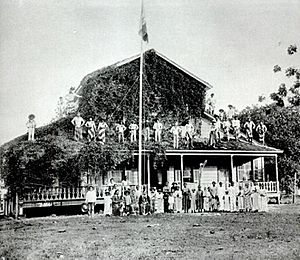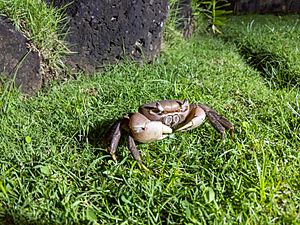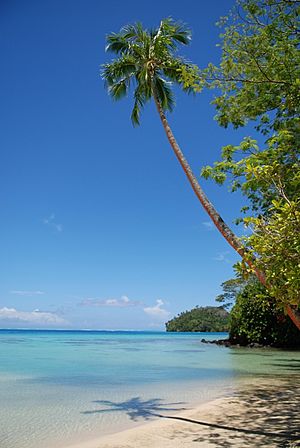Huahine facts for kids
Quick facts for kids
Huahine
|
||
|---|---|---|
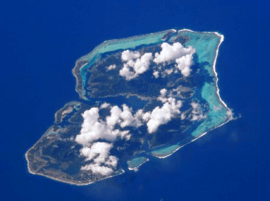
NASA picture of Huahine viewed from the north
|
||
|
||
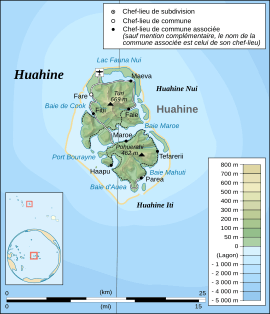 |
||
| Country | France | |
| Overseas collectivity | French Polynesia | |
| Subdivision | Leeward Islands | |
| Area
1
|
75 km2 (29 sq mi) | |
| Population
(2017)
|
6,075 | |
| • Density | 81.0/km2 (209.8/sq mi) | |
| Time zone | UTC– 10:00 | |
| INSEE/Postal code |
98724 /98731
|
|
| Elevation | 0–669 m (0–2,195 ft) | |
| 1 French Land Register data, which excludes lakes, ponds, glaciers > 1 km2 (0.386 sq mi or 247 acres) and river estuaries. | ||
Huahine is a beautiful island in the Pacific Ocean. It's part of French Polynesia, which is a territory of France. This island belongs to the Society Islands group, specifically the Leeward Islands. In 2017, about 6,075 people lived there.
Contents
Discovering Huahine's Past
People have lived on Huahine for a very long time. We know this because of the many ancient temples, called marae, found on the island. Experts believe that the ancient Tahitian Ma'ohi people settled here around the 9th century AD. Huahine has one of the largest collections of Polynesian historical sites from 850 AD to 1100 AD.
Huahine's Own Kingdom
Until the late 1800s, Huahine was an independent kingdom. It was also known as the Huahine and Maia'o Kingdom. History tells us that three main royal families ruled the island:
- The Hau-mo'o-rere family started in the 1600s. Its last ruler was Queen Teha'apapa I. Captain Cook met her in 1769. She worked hard to keep her kingdom strong and independent.
- The Tamatoa family came from Queen Teha'apapa I and her husband, Mato a Tamatoa. He was from the Tamatoa family of Raiatea. This family ruled Huahine until 1854.
- The Teurura'i family began with Ari'imate Teurura'i, a Huahine chief, and his wife Teri'iteporouara'i Tamatoa. She was also from the Tamatoa family of Raiatea and a great-granddaughter of Queen Teha'apapa I. This family ruled from 1854 to 1895.
A Polynesian prince named Teriifa'atau Marama could have become king of both Huahine and Raiatea. But it was decided that his younger brother would rule Raiatea instead.
In 1884, Teriifa'atau Marama became the prime minister of Huahine. His younger brother had held this job before becoming King of Raiatea.
Teriifa'atau Marama played a big part in Huahine becoming part of France. In 1895, the queen's representative and the main chiefs of the kingdom officially gave up their power to France. This happened in a treaty signed on September 15, 1895.
After Huahine became part of France, Teriifa'atau Marama was chosen as chief of Tefareri'i. He held this position until he passed away.
European Visitors and Changes
The name Huahine is said to mean "pregnant woman." This is because the shape of Mount Tavaiura looks like a pregnant woman lying down.
Captain James Cook arrived in Fare Harbour on July 16, 1769. He was guided by Tupaia on his ship, HMS Endeavour. They met the main chief, Ori. Cook came back on September 3, 1773. This time, he met Ori's son, Teri'itaria, who was the new leader of the island.
A missionary named Auna worked on Huahine before going to Hawaii.
A Spanish explorer, Domingo Bonaechea, visited in 1775. He called the island "La Hermosa," meaning "The Beautiful." Today, it's sometimes called "the island of the woman."
In 1846, the people of Huahine fought against French rule and won. They did not want to be controlled by another country. In 1847, the island declared itself an independent state, calling itself the Kingdom of Huahine.
On April 20, 1879, Germany signed a friendship and trade agreement with Huahine. This was done by Karl Deinhard, commander of the SMS Bismarck, and Gustav Godeffroy Junior, a German consul.
In 1888, France finally set up a protectorate over the island. This meant France would protect Huahine but not fully control it yet. However, in 1895, the independent kingdom of Huahine and Maia'o was fully taken over by France. The last queen, Te-ha'apapa III, was removed from power. Huahine then became part of the French Establishments of Oceania, which is now French Polynesia.
Huahine's Geography
Huahine is about 16 km (10 mi) long and 13 km (8 mi) wide. It's made up of two main islands surrounded by a coral reef and small islets called motu. Huahine Nui (Big Huahine) is in the north, and Huahine Iti (Little Huahine) is in the south. The total land area is 75 square kilometers. The two islands are very close, separated by only a few hundred meters of water. They are connected by a sandbar at low tide. A small bridge was built to make it easier to travel between Huahine Nui and Huahine Iti. The highest point on the island is Mount Turi, which is 669 meters tall.
In the northwest of Huahine Nui, there's a 375 hectares (926.65 acres) lake called Lac Fauna Nui. This lake is all that's left of an ancient lagoon. You can fly to Huahine through Huahine – Fare Airport, which is on the northern shore of Huahine Nui.
Plants and Animals of Huahine
The island is covered with lots of green plants, especially coconut trees. There are also two important gardens:
- The Ariiura Garden Paradise, which grows traditional Polynesian medicinal plants.
- L'Eden Parc, where fruit trees from all over the world are grown.
Huahine has many different kinds of fish and birds. One bird, the Huahine starling, disappeared centuries ago. Its fossils found on the island show it died out about 700 years ago.
How Huahine is Governed
Huahine is a commune (like a town or municipality) in French Polynesia. It's part of the Leeward Islands administrative area. Huahine includes several smaller areas called associated communes:
- Faie
- Fare
- Fitii
- Haapu
- Maeva
- Maroe
- Parea
- Tefarerii
The main administrative center of Huahine is the town of Fare, located on Huahine Nui.
People of Huahine
In 2017, the total population of Huahine was 6,075 people. These people live in eight villages: Fare (the main town), Maeva, Faie, Fiti'i, Parea, Tefareri'i, Ha'apu, and Maroe.
The main jobs on the island include growing vanilla, making copra (dried coconut meat), fishing, and working in tourism.
Sports and Activities
Huahine is famous for a big Polynesian canoe (va'a) race called the Hawaiki Nui Va'a. This international competition is held between Huahine and nearby islands like Bora Bora, Tahaa, and Raiatea.
Religion on Huahine
Most people on Huahine are Christian. This is because missionaries from the Catholic Church and various Protestant groups came to the island during European colonization.
Protestant missionaries first arrived in 1809. In 1815, they ordered the destruction of the idols of the old local gods. Catholic missionaries came later. The first chapel on the island was built between 1819 and 1820.
Catholics on the island are part of the Archdiocese of Papeete. They have one church, the Church of the Holy Family (Église de la Sainte-Famille). It was reopened in Fare on October 30, 2010. The original church was built between 1906 and 1909.
Huahine's Economy
The people of Huahine work in farming and fishing. They grow vanilla (a special kind called vanilla tahitiensis) and different types of melons. Because there are so many coconut trees, making copra (dried coconut meat) is also very important for the local economy.
Tourism on Huahine
Tourism is a big part of Huahine's economy. Many visitors arrive by cruise ship or by plane at the airport.
One popular attraction is a bridge over a stream with long freshwater eels. These eels are considered sacred by the local people, according to their stories. Visitors can buy mackerel to feed these eels. The Fa'ahia archaeological site in the north of the island has found old bones of several kinds of extinct birds. These birds were wiped out by the first Polynesian settlers on the island.
Getting Around Huahine
You can fly to Huahine! Air Tahiti offers regular passenger flights using ATR turboprop planes. These flights arrive at the Huahine - Fare Airport.
See also
 In Spanish: Huahine (isla) para niños
In Spanish: Huahine (isla) para niños



